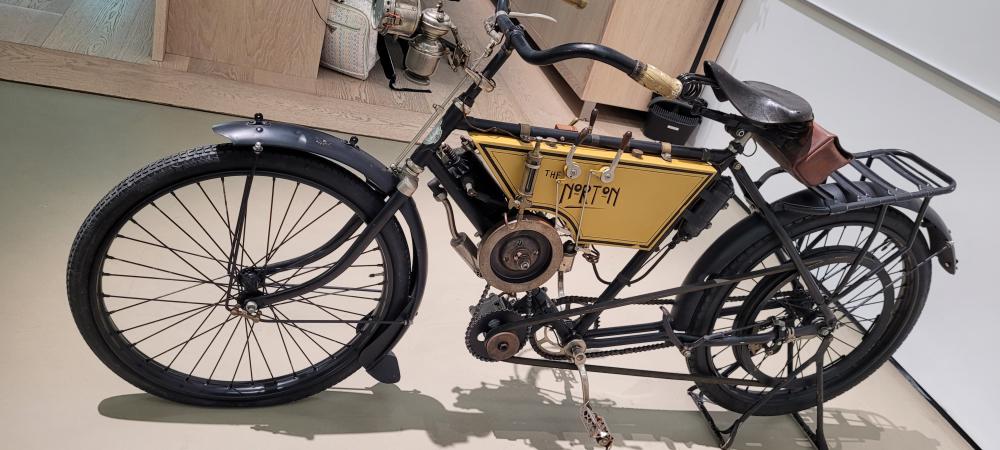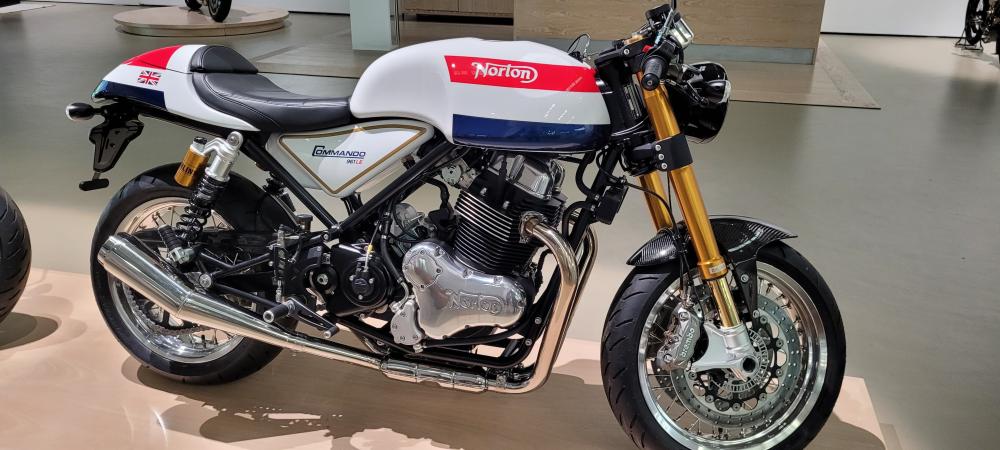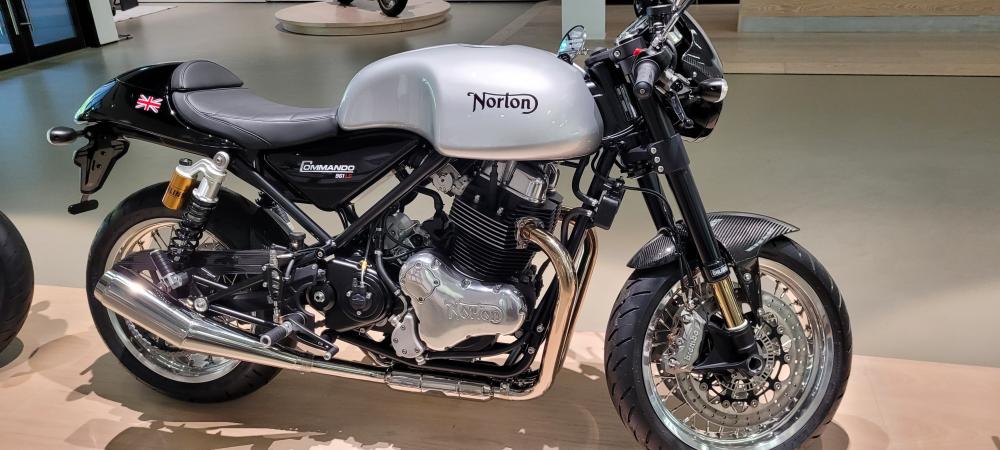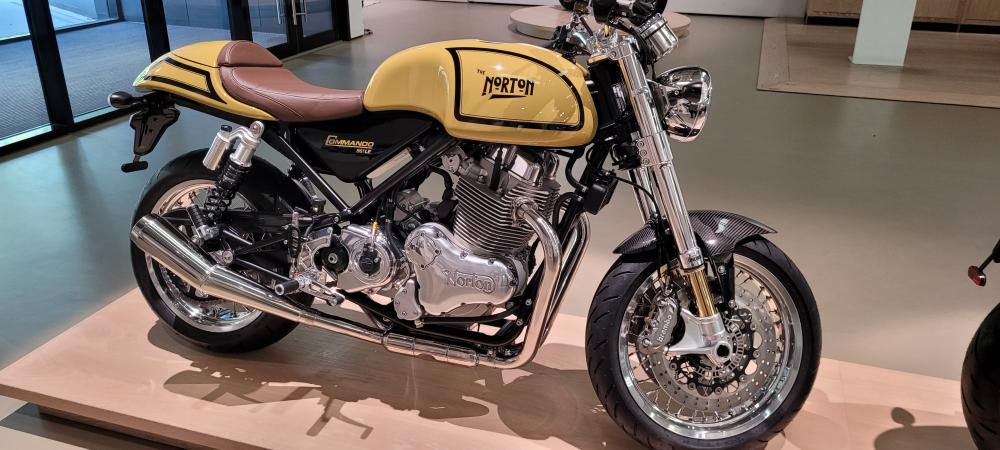1967 to 1978
Following the acquisition of AMC in 1966 it quickly became apparent to Norton Villiers that a new flagship machine would be needed to replace the ageing Featherbed framed machines. The 800cc OHC P10 prototype was taken out of mothbalIs and reassessed for suitability. It was given the thumbs down on a number of points, poor performance potential and vibration being among them. The chain drive to the camshafts was almost as long as a final drive chain. So with just three months to go before the 1967 Earls Court Show the decision was taken to go ahead with an idea credited to Bernard Hooper of hanging a rubber mounted Atlas engine in a completely new frame with a massive single top tube. Hooper and Bob Trigg thereupon got to work to finish the design and produce a machine in time for the Show. The Commando duly made its debut at Earls Court where it was received by the public with much enthusiasm.
It was in many ways a very radical design, especially with the engine, gearbox, swinging arm and rear wheel being mounted on a rubber bush arrangement that was patented as 'Isolastic'. The system, though effectively insulating the rider from vibration did have the disadvantage that the mounting rubbers had to be regularly shimmed up in order for the machines handling to be kept up to standard. A vernier adjustment system had also been patented, but it was not to be incorporated until the final couple of years of Commando production, the cost accounts people apparently thought the convenience was too expensive. Some other points of interest were the triplex primary chain, now properly housed in an alloy casing instead of the dreadful pressed tin affair long beloved by Norton, the petrol tank and matching tail piece were made out of fibreglass and the gaudy orange seat had forward projecting wings that overlapped on to the tank. A twin leading shoe front brake was a standard fitment.
The first production models were completed in April 1968. These were now fitted with a Laycock designed diaphragm spring clutch giving good grip combined with a light lever action. Another worthwhile addition was a timing plate to allow the checking of ignition timing by stroboscope. There were some frame bending problems with early production machines but this was cured by the introduction of a revised frame in January 1969. The original Commando was now known as the Fastback model, it was joined in March by the 'S' Type version. This had a high level left side exhaust system, a 2½ gallon petrol tank and naked front forks without gaiters or shrouds.
The factory at Burrage Grove, Plumstead had become the subject of a Greater London Council compulsory purchase order late in 1968. The logical move in most peoples eyes would have probably been to move the Commando lock, stock, and barrel into the old Villiers factory at Wolverhampton, but the carrot of a Government subsidy to move to a development area apparently proved irresistible so the assembly line was set up on a factory estate at North Way, Andover. The test department also removed to Andover, but to an aircraft hanger on nearby Thruxton Airfield. The manufacturing side was transferred to Wolverhampton however and complete engine/gearbox units were ferried to Andover overnight. The last Commando left Plumstead in July 1969, thus bringing motorcycle production on the site to a close after over 60 years. The building itself was demolished in 1971 to make way for a housing development. September 1969 saw the contact breaker moved to the front of the timing cover and driven by the camshaft, the rev counter drive moving inboard as a consequence.
The USA was always an important export market so the NV Corporation was set up at Long Beach, California to handle sales in the seven Western states with Joe Berliner as franchise agent for the rest of the country. Police forces were also perceived as valued regular customers so Neale Shilton had been recruited in late 1968 after many years at Triumph in order to create a Police specification Commando and secure orders at home and abroad. This he did to good effect and the Interpol machine was to sell steadily over the next few years.
The Commando had been used for racing from an early stage and after a win in the 1969 Hutchinson 100 and a second place in the Production TT it was announced that a Production Racer would be put on public sale, this to feature a tuned engine and front disc brake. Its all yellow livery quickly earned it the title of 'Yellow Peril'. A performance shop was opened at Thruxton to produce these machines along with various custom parts for sale under the Norvil brand name. Peter Williams joined the development team at Thruxton and was to combine his technical abilities with top class racing skills.
March 1970 saw the introduction of another variant of the Commando, the Roadster. This had similar styling to the 'S' Type but with a low level exhaust with silencers angled upward and reverse cones. The 'S' itself was discontinued in June. September saw a restyled Fastback Mk. 2 , but this was shortly replaced by the Mk. 3 which had no fork gaiters, but with alloy levers and modified stands and chainguard. By now the Roadster was in its Mk. 2 form.
The Street Scrambler and Hi Rider both appeared in about May 1971, the former only lasted for five months and had a small petrol tank and Americanised styling. The latter had ape hanger bars and a chopper seat, presumably also mainly aimed at the American market. Variation of the month for June was the Fastback Long Range. This was similar to the Mk. 3 Fastback but with an Atlas type petrol tank and restyled seat. The last month of 1971 saw a disc brake conversion kit being offered to fit all Commandos (or any other Roadholder forked machine of course), a rubber cush drive was now incorporated into the rear hub in order to smooth out the drive. Quality control had always been a problem on the Commando, perhaps more so than on any other postwar Norton, Mutterings of this were filtering into press reports, one magazine found a test machine prepared so badly they returned it and asked for another, which proved only marginally more acceptable. One unfortunate reason for this was friction between various individuals in senior positions that often thwarted the efforts of others to sort things out for the general benefit of company and customers.
Late in 1971 the John Player sponsored racing team started under the management of Frank Perris, himself an ex-racer who had spent some years in the successful Suzuki team. Peter Williams was of course the mainstay of the JPN racing effort and was partnered by various other well known riders over the next few years.
January 1972 heralded the appearance of the Mk. 4 Fastback and Roadster models, with front disc brake, direction indicators and strengthened crankcase. The 750 Interstate also made its debut, with a five gallon petrol tank and the high performance Combat engine. This gave 65 BHP at 6500 rpm with a 10 to 1 compression ratio, the original Atlas had a ratio of 7.3 to 1 by way of comparison. It wasn't long before owners of the new machine were complaining of reliability problems, main bearing failures were numerous, as were pistons breaking off at a slot under the oil control ring and many units were returned to the works for rectification under warranty. The Combat received a number of modifications over the next few months in order to try and improve reliability, special barrelled main bearings and a lowered compression ratio both proved effective in this. The whole Combat episode had a financially detrimental effect on the Company, the harm done to its reputation was not inconsequential either.
In mid 1972 the BSA-Triumph Group were in a serious financial position, the Government of the day agreed to provide finance to rescue the ailing giant on condition that the motorcycle division merged with Norton Villiers. It was a bit like asking Jonah to swallow the whale, but Norton Villiers Triumph (NVT) thereby came into existence and a whole new troubled chapter opened up. Among the more interesting BSA assets so acquired were the designs for a Wankel type rotary engine. Major modifications to the Commando clutch and a replacement oversize swinging arm pivoting spindle came out late in the year, the front disc brake was now standard on all models.
The Fastback got a Mk. 5 tag, with the Mk. 4 and Long Range being dropped in the first month of 1973. April saw the introduction of the 828cc engine. This retained the same 89mm stroke as the 750 but was overbored to 77mm. It appeared in Roadster, Hi Rider and Interstate versions, following modifications a few months later the Roadster and Interstate became a Mk. la.
On the race track, Peter Williams won the 1973 Formula 750 TT with team mate Mick Grant in second place. This was to prove Norton's last TT success with a reciprocating engine, sixty six years after their first. In September the plan to use a Cosworth designed engine in the works racers was announced, with eventual road going versions as well. Also in the same year a prototype 500cc twin with stepped piston engine was built at Wolverhampton, this was known as the Wulf and featured a monocoque pressed steel frame. Both these projects were eventually dropped in favour of developing the Rotary design, though the Cosworth did eventually get onto the race track, but with little success in spite of the spirited efforts of Dave Croxford. Cosworth were very big in the Formula 1 car engine business at the time and it was hoped that their expertise could provide Norton with a world beater, but problems arose with the engines supplied to Norton and it all came to nought.
All was not well behind the public face of the Company, there was industrial unrest at Andover where the staff had a sit in following the issuing of redundancy notices and later in 1973 the big Meriden trouble began. There were a long list of modifications made to production machines, among these were higher load Superblend bearings for the 828 models and stellite tipped inlet valves, a new head steady and car type oil filter kit on the 750. The last 750cc machines were manufactured late in 1973.
Early 1974 saw the 828 Roadster and Interstate machines labelled Mk. 2a after acquiring improved cylinder head porting and a quilted look dualseat. The Hi Rider was now a Mk. 2. In April the JPN Replica appeared, really a Mk. 2a Roadster with a full fairing and go faster equipment. Finished in white it looked a very striking machine with its twin headlamps built into the fairing. It was only in production for about twenty months, one estimate is 250 units so it is a fairly rare bird. A special short stroke 750cc version was also made in limited numbers for race track use. This was quite a successful year as far as racing was concerned, even though the old engines were being used in the new spaceframe designed for the Cosworth unit. Unfortunately Peter Williams racing career was cut short by a bad accident at Oulton Park when the seat apparently became detached, throwing him off at speed. John Player's sponsorship of the race team ended after the 1974 season and although Norton carried on alone for the next year it was a luxury that could not last.
The Government subsidy that NVT heavily relied upon and was mainly using for the development of future machines was withdrawn in June 1974. It is interesting to note that the incoming Labour Government was to employ the restoration of the grant as a lever against NVT to acquiesce with the setting up of the Meriden Co-operative. The Company had now entered a very troubled period. It had been decided to shrink the existing four sites into two, namely Small Heath and Wolverhampton. This did not go down well at Meriden, there was a workers sit in that was much publicised in the press and TV and cost NVT in the region of £20,000 per week and paralysed Small Heath's Trident production. It was hardly surprising that an over £3M trading loss was announced for the year.
The Norton range was pruned early in 1975 to leave just the Mk. 3 Interstate and Roadster, these now having an electric starter, rear disc brake and to the horror of traditionalists a left side gearchange and right footbrake. The electric starter turned out to be a non starter in most owners eyes, but fitting a Prestolite or Lucas four brush conversion made it more suited for its purpose. There were over 100 detail changes from the previous models, the Isolastic system at last got the vernier adjustment that eliminated the need for shims, a higher output alternator was fitted and the exhaust joint at the cylinder head was modified. This then became the Commando in its final form.
In July 1975 the Industry Minister refused to renew NVT's export credits and furthermore recalled a £4M loan, effectively pushing the Company over the edge and into the clutches of the Receiver, though in the opinion of some well placed people the policies of the directorate may have led the firm there anyway. Mass redundancies were announced at the various NVT sites, an action committee was formed at Wolverhampton with the aim of continuing production of the Commando and developing the Wulf project. A prototype named the Norton 76 was produced with SU carburettor and Italian forks and brakes.
NVT was saved from total liquidation late in 1976 by the Government eventually stepping in to save part of the operation. A new company, NVT Engineering Ltd. was formed with Dennis Poore at the head and a workforce of 300. The production of Commando spares was slowed but never entirely ceased, as years went by market demand for these did not tail off and most parts are still being made over ten years after the last machine was produced. But back to 1976, the Wolverhampton works was put into the hands of the Liquidator and he supervised the completion of all the part finished machines on site before selling the works to a purchaser willing to take on most of the employees. The outstanding 1500 machines were finished off by September 1977, another 30 were put together at Andover in 1978 and that was the end of the road for the Commando.
THE END
Author's Note
A number of books have been invaluable in the preparation of this series of articles, but special mention must be made of those titles by Roy Bacon, Bob Holliday and Steve Wilson. I recommend them to all those in need of further enlightenment into the history of Norton.
Peter Thistle
© Norton Owners Club 1989 & 2010
Amended version of the original published in the Norton Owners Club Classic Calendar for 1989





